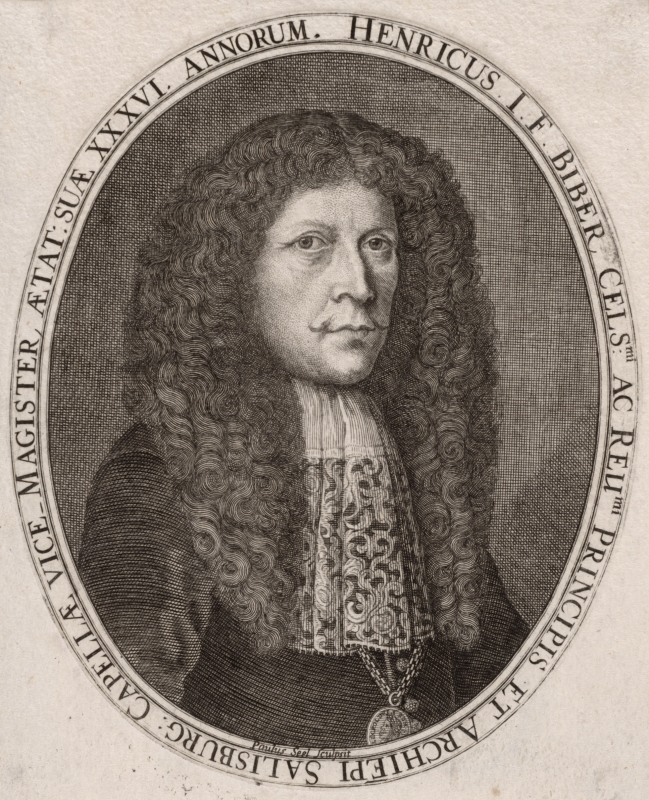Named by historians the most important composer of the 17th century, Austrian composer Heinrich Ignaz Franz Biber composed prolifically for the violin. Biber, one of the best violinists of his time, was able to execute performing in high positions (difficult on a Baroque violin, which has no shoulder or chin rest!), multiple double stops, and was a master of scordatura (tuning the violin in intervals other than fifths). His collection of 15 Mystery Sonatas (aka the Rosary Sonatas), are based on the 15 Mysteries of the Rosary: Catholic devotional prayers meant for contemplating the lives of Jesus and Mary. The Mystery Sonatas were probably devotional as well as artistic in nature.
The Passacaglia that ends the collection of Rosary Sonatas is not based on a Mystery, but probably referenced the Feast of the Guardian Angels. The piece is named the “Guardian Angel Passacaglia” for the engraving of an angel leading a child at the beginning of the piece. It is one of the earliest known pieces for unaccompanied violin and is one of two pieces in the set that incorporates normal violin tuning (versus exploratory scordatura). The collection was dedicated to Biber’s employer, Archbishop Maximilian Gandolph von Khuenburg who, according to Biber, strongly advocated devotion to the Rosary.
H. I. Biber wrote the 15 Mystery Sonatas in alternate tunings for the violin, called scordatura. The Guardian Angel Passacaglia, however, is tuned traditionally. This video explains scordatura in the classical tradition, using the Mystery Sonatas as an example. For more information on the traditions surrounding scordatura (cross-tuning) in folk music, see this video: Cross-Tuning on the Fiddle, a.k.a. Scordatura.
Classical cross-tuning/scordatura.
Folk cross-tuning.
Composed in 1676, the Mystery Sonatas remained practically undiscovered until their publication in 1905. The only manuscript resides in the Bavarian State Library in Munich. The collection has 3 cycles corresponding to each set of Rosary Mysteries – the Joyful, Sorrowful and Glorious Mysteries. Historians conjecture that the sonatas were played in Rosary processions: processions to paintings or sculptures depicting the mysteries (while praying the Rosary), similar to the Stations of the Cross.
A passacaglia is a triple meter dance that in 17th century France would have been a serious, elegant affair, probably performed by male dancers. Its structure incorporates a theme and variations centered around its bass line.
The Guardian Angel is divided into four parts: Passacaglia, Adagio, Allegro, Adagio, with a small coda at the end. Each part incorporates various virtuosic techniques to show off the capabilities of the violin: arpeggios, chords, runs, and even ricochet (a thrown bow stroke). The Passacaglia would have been performed on the Feast of the Guardian Angels. In addition to the engraving of the guardian angel preceding the piece, the Passacaglia incorporates an omnipresent, repeating bass line of 4 notes – G, F, Eb, D. These notes are also the bass line of a hymn to a Guardian Angel. This ostinato (repeated note) bassline structure is believed to have inspired Bach’s 6 Sonatas and Partitas, making the Passacaglia the most important precursor to Bach’s unaccompanied violin works.
Elicia Silverstein performs the Passacaglia on baroque violin.

